What is Pykw file extension
.Pykw file extension is a file extension that is associated with the newest version of widespread ransomware called STOP (Djvu). This malware was discovered by security researchers recently. Upon infecting a computer, it encrypts files on the computer, renames the affected files, adding .Pykw extension at the end of their filenames, and demands a ransom for a key that will allow the computer owner to decrypt the files. Fortunately, there is a free Pykw File Decrypt Tool called ‘STOP (Djvu) Decryptor’ that allows in some cases to decrypt encrypted files. Scroll through this article below to learn more about this decrypt tool and how to use it, as well as alternative ways to recover the contents of encrypted files.
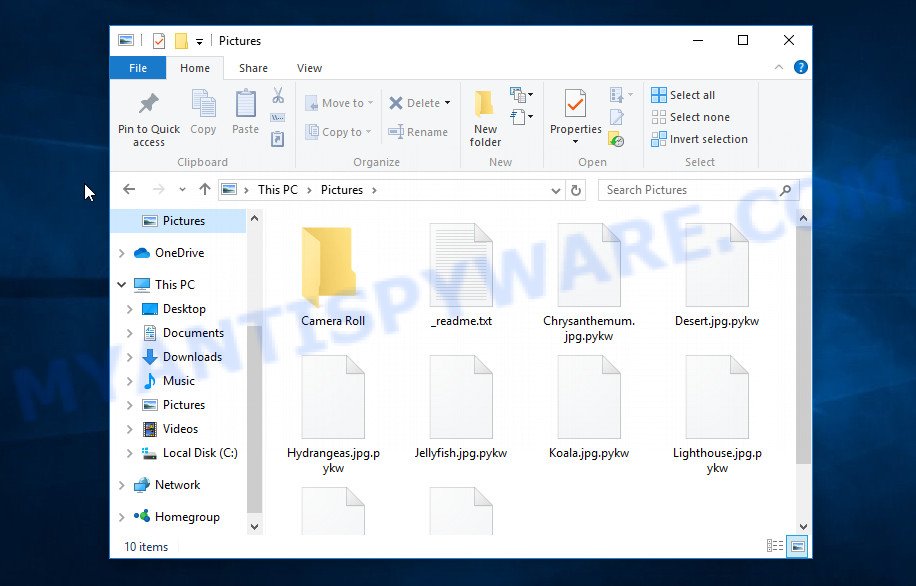
Screenshot of files encrypted by Pykw ransomware virus (‘.pykw’ file extension)
What is Pykw ransomware virus
First discovered recently, Pykw ransomware is the newest version of STOP ransomware. Ransomware is a type of malware that encrypts files on the victim’s computer and demands a ransom payment to restore access to the contents of these files. Pykw targets users running Microsoft Windows. In most cases, this malware requires user actions in order to be installed on the computer. Typically, criminals use various tricks, for example, disguising the malicious software as a freeware, cracks, activators and key generators, so that victims download and run Pykw virus on their computer.
Upon infecting a computer, it performs the following steps as part of its preparation for encrypting files: creates a folder in the Windows system directory and copies itself to it; adds itself to the list of programs that start up every time the computer is turned on; collects information about the victim’s computer; establishes connection with its command server (C&C).
If the Pykw ransomware was able to establish a connection with the C&C server, then it sends some information about the victim’s computer to the server, and the server returns a key to it that must be used to encrypt files. Such a key is called ‘online key’ and it is unique for each case of ransomware infection. If a connection to the C&C server has not been established, the ransomware uses a fixed key (so called ‘offline key’), which is unique for each version of STOP (djvu) ransomware, but the same for each case of Pykw infection.

Having determined which key to use, the Pykw ransomware virus goes to the main thing – it starts the file encryption process. Of course, it does not encrypt absolutely all files, since encryption of the Windows system files will cause the computer to stop working. Therefore, the ransomware does not encrypt files located in the system directory of Windows, as well as files with the following extensions: ‘.sys, .dll, .lnk, .ini, .bat’. In addition, Pykw virus does not encrypt files named ‘_readme.txt’. All other files will become the target of the malware, for example, the following file types can be encrypted:
.slm, .0, .dba, .wdb, .wm, .vfs0, .mpqge, .flv, .db0, .mdb, .xlsx, .mov, .m2, .accdb, .docm, .wmv, .wmv, .tax, .wsc, .p7b, .hplg, .cfr, .eps, .ntl, .w3x, .wp6, .wpl, .mp4, .wmd, .snx, .desc, .raf, .rar, .xf, .doc, .xbplate, .xll, .1st, .wav, .wotreplay, .sr2, .wmo, .lbf, .3fr, .webp, .ncf, .kdc, .cer, .wire, .rtf, .docx, .der, .psk, .mef, .fpk, .3ds, .xar, .wp7, .wot, .wbmp, .rwl, .pkpass, .2bp, .xlgc, .zw, .ibank, .bar, .py, .xls, .odc, .ltx, .wdp, .orf, .mcmeta, .fos, .wpt, .sie, .arw, wallet, .forge, .wp4, .mddata, .vcf, .ff, .zdb, .kdb, .itl, .wp, .psd, .rw2, .wbz, .esm, .pak, .txt, .x3f, .xmind, .wps, .odp, .vpk, .dxg, .wbm, .bc6, .ybk, .wpb, .bkp, .rim, .fsh, .png, .dazip, .epk, .dwg, .nrw, .odt, .litemod, .bc7, .pst, .wpd, .das, .sis, .ai, .dbf, .pem, .wpd, .asset, .webdoc, .xdl, .xbdoc, .sum, .xml, .xmmap, .wpg, .qdf, .pptm, .ws, .rofl, .wma, .apk, .wri, .xlsm, .zi, .r3d, .jpe, .big, .cdr, .indd, .wcf, .zdc, .bsa, .wbk, .syncdb, .xld, .xls, .js, .vpp_pc, .wb2, .crt, .zif, .t13, .xwp, .blob, .pdf, .xlsm, .wpw, .zabw, .m3u, .jpg, .erf, .csv, .gdb, .srf, .wmf, .dmp, .ztmp, .pfx, .wsh, .xy3, .svg, .gho, .map, .xxx, .sid, .sidn, .odm, .crw, .tor, .xlsx, .cr2, .7z, .pptx, .ppt, .zip, .re4, .wpa, .xyp, .itm, .bik, .y, .dcr, .kf, .iwd, .sql, .lvl, .wma, .mdbackup, .wpe, .wbc, .wn, .bay, .hvpl, .rb, .layout, .x3f, .hkdb, .wp5, .z3d, .wps, .arch00, .bkf, .qic, .ptx, .ysp, .xyw, .cas, .xlsb, .yal, .upk, .p7c, .hkx, .mlx, .ods, .lrf, .x3d, .3dm, .css, .itdb, .x, .jpeg, .mrwref, .t12, .d3dbsp, .avi, .rgss3a, .srw, .p12, .xpm, .odb, .wgz, .dng, .wsd, .raw, .vtf, .m4a, .sidd, .1, .pdd, .xx, .menu, .yml, .pef, .iwi, .vdf, .xlk, .sb, .zip, .z, .xdb, .mdf, .icxs, .sav, .wbd
All encrypted files become completely useless, their contents cannot be read in any way. To clearly show that the files are encrypted, the ransomware virus appends a new ‘.pykw’ extension at the end of the filename of each encrypted file. This means the following: if the file had the name ‘photo-image.jpg’, then after it has been encrypted, it will be called ‘photo-image.jpg.pykw’. In all directories where there are encrypted files, the Pykw virus drops a file named ‘_readme.txt’
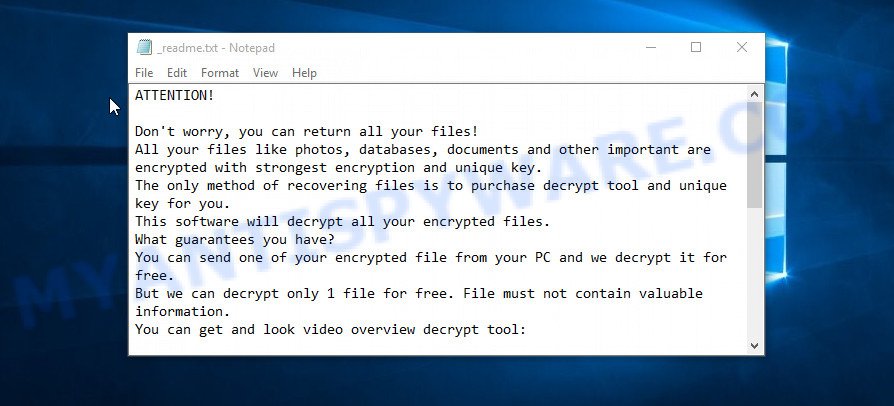
Screenshot of the contents of ‘_readme.txt’ file (ransom demand message)
This file contains text written by the Pykw authors. In this message, the criminals report that the user’s files were encrypted and the only way to get them back is to purchase a key and a decryptor. Attackers give the victim 72 hours. At this time, the key will cost $490, after 72 hours the ransom will increase to $980. The message also contains the contact information of the criminals, using which the victim can check the ability of the attackers to decrypt .pykw files, as well as find out where to send the ransom.
The full text of the Pykw ransomnote:
ATTENTION!
Don’t worry, you can return all your files!
All your files like photos, databases, documents and other important are encrypted with strongest encryption and unique key.
The only method of recovering files is to purchase decrypt tool and unique key for you.
This software will decrypt all your encrypted files.
What guarantees you have?
You can send one of your encrypted file from your PC and we decrypt it for free.
But we can decrypt only 1 file for free. File must not contain valuable information.
You can get and look video overview decrypt tool:
https://we.tl/t-Gf8avvBuir
Price of private key and decrypt software is $980.
Discount 50% available if you contact us first 72 hours, that’s price for you is $490.
Please note that you’ll never restore your data without payment.
Check your e-mail “Spam” or “Junk” folder if you don’t get answer more than 6 hours.To get this software you need write on our e-mail:
helpmanager@mail.chReserve e-mail address to contact us:
restoremanager@airmail.ccYour personal ID:
Threat Summary
| Name | Pykw ransomware, Pykw file virus |
| Type | Filecoder, Crypto virus, File locker, Ransomware, Crypto malware |
| Encrypted files extension | .pykw |
| Ransom note | _readme.txt |
| Contact | helpmanager@mail.ch, restoremanager@airmail.cc |
| Ransom amount | $980/$490 in Bitcoins |
| Detection Names | Ransom.STOP!8.10810 (CLOUD), Trojan:Win32/Obfuscator.SL!MTB, Win32.Trojan-Ransom.STOP.KLJJ07, Trojan.TR/AD.InstaBot.ldg, Win32/Kryptik.HEHT, Trojan.Graftor.DBE92B, BehavesLike.Win32.SoftPulse.bc, Artemis!405BBFCC6294 |
| Symptoms | Encrypted personal files. Windows Explorer displays a blank icon for the file type. Your file directories contain a ‘ransom note’ file that is usually a .html, .jpg or .txt file. Desktop wallpaper is changed to the ransom note. |
| Distribution methods | Phishing Emails that is carefully designed to trick a victim into opening an attachment or clicking on a link that contains a harmful file. Malicious downloads that happen without a user’s knowledge when they visit a compromised webpage. Social media posts (they can be used to entice users to download malicious software with a built-in ransomware downloader or click a malicious link). Torrent webpages. |
| Removal | Pykw ransomware removal guide |
| Decryption | Pykw File Decrypt Tool |
In file ‘_readme.txt’, criminals scare victims by saying that encrypted files cannot be decrypted without paying a ransom. And unfortunately this is true, the contents of the files cannot be read while the files are encrypted, and a key and decryptor are needed to decrypt them.
Fortunately, there is a free Pykw File Decrypt Tool. This decryptor can help each victim to decrypt .pykw files for free. But in addition to the decryptor, the key is still necessary. As we reported above, the virus can use two types of keys. An offline key can be determined by researchers, but only criminals have an online key. Thus, files encrypted with so called ‘offline key’ can be decrypted. And all files that have been encrypted with so called ‘online key’ cannot yet be decrypted. In this case, the alternative methods listed below in this article can be used to recover the contents of these files.
How to remove Pykw ransomware and Descrypt (recover) .pykw files
If your documents, the files of your friends or colleagues, were encrypted by the Pykw ransomware virus, then you need to follow the steps listed below that will allow you to find and remove Pykw, as well as decrypt or restore the encrypted files. It is very important to read the entire instruction manual carefully and make sure to understand it all. We advise you not to skip any steps, each of the steps is very important and must be completed by you. In order not to get confused and not miss an important point in the instructions, we recommend that you print this article or open it on your smartphone.
- How to remove Pykw ransomware
- How to decrypt .pykw files
- How to restore .pykw files
- How to protect your PC from Pykw ransomware
How to remove Pykw ransomware
Before you start decrypting or recovering .pykw files, you need to remove the Pykw autostart entries. This must be done since otherwise the ransomware may re-encrypt the restored files. You can stop the ransomware from working, as it is not difficult to do. Another option is to perform a full system scan using free malware removal tools capable of detecting and removing ransomware infection.
It is very important to scan the computer for malware, as security researchers found that spyware could be installed on the infected computer along with the Pykw ransomware. Spyware is a very dangerous security threat as it is designed to steal the user’s personal information such as passwords, logins, contact details, etc. If you have any difficulty removing the Pykw virus, then let us know in the comments, we will try to help you.
To remove Pykw ransomware, follow the steps below:
- Kill the Pykw ransomware process
- Disable the Pykw ransomware Start-Up
- Delete the Pykw ransomware Task
- Scan computer for malware
Kill the Pykw ransomware process
Press CTRL, ALT, DEL keys together.

Click Task Manager. Select the “Processes” tab, look for something suspicious that is the Pykw ransomware then right-click it and select “End Task” or “End Process” option.
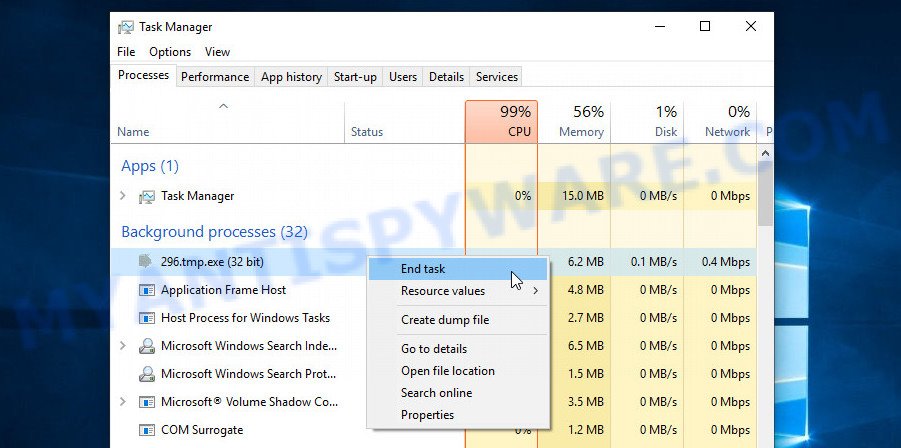
A process is particularly suspicious: it is taking up a lot of memory (despite the fact that you closed all of your programs, its name is not familiar to you (if you are in doubt, you can always check the program by doing a search for its name in Google, Yahoo or Bing).
Disable the Pykw ransomware Start-Up
Select the “Start-Up” tab, look for something similar to the one shown in the example below, right click to it and select Disable.
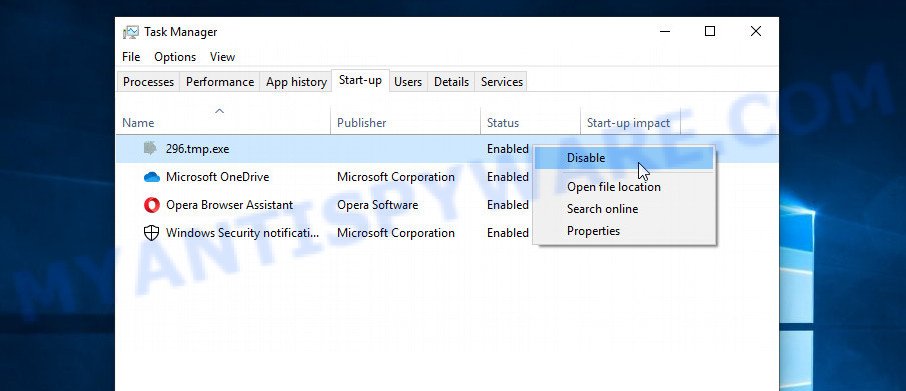
Close Task Manager.
Delete the Pykw ransomware Task
Type “Task Scheduler” in the search bar. Click Task Scheduler app in the search results. Click “Task Scheduler Library” in the left panel. On the right panel, right-click to “Time Trigger Task” and select Delete.
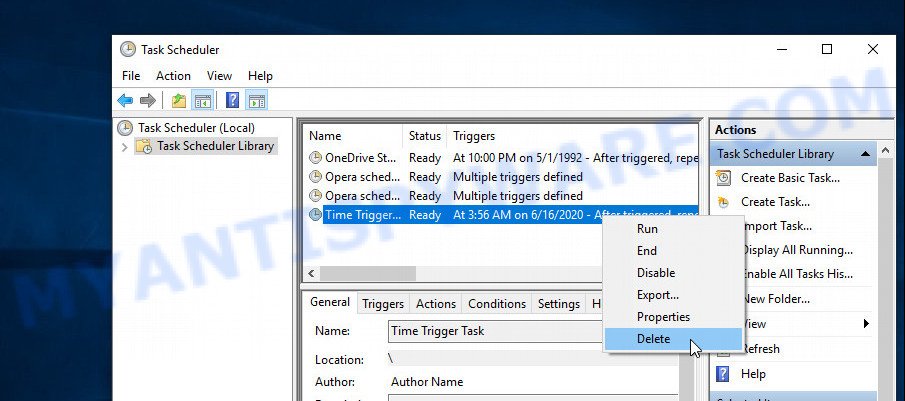
Close Task Scheduler.
Scan computer for malware
Zemana Anti-Malware can detect and remove ransomware, as well as a variety of Trojans, viruses, spyware, worms and rootkits. After the detection of the Pykw crypto malware, you can easily and quickly remove it.

- Zemana AntiMalware can be downloaded from the following link. Save it to your Desktop so that you can access the file easily.
Zemana AntiMalware
164810 downloads
Author: Zemana Ltd
Category: Security tools
Update: July 16, 2019
- At the download page, click on the Download button. Your web browser will display the “Save as” dialog box. Please save it onto your Windows desktop.
- After the download is finished, please close all programs and open windows on your system. Next, launch a file called Zemana.AntiMalware.Setup.
- This will start the “Setup wizard” of Zemana Free onto your computer. Follow the prompts and do not make any changes to default settings.
- When the Setup wizard has finished installing, the Zemana AntiMalware (ZAM) will run and show the main window.
- Further, click the “Scan” button to start scanning your system for the Pykw ransomware virus, other malicious software, worms and trojans. Depending on your computer, the scan can take anywhere from a few minutes to close to an hour. During the scan Zemana AntiMalware will scan for threats exist on your computer.
- After the system scan is finished, Zemana Anti-Malware (ZAM) will show a list of all items detected by the scan.
- Make sure to check mark the items which are unsafe and then press the “Next” button. The utility will uninstall Pykw ransomware virus, other kinds of potential threats like malicious software and trojans and move the selected threats to the program’s quarantine. When the procedure is finished, you may be prompted to reboot the computer.
- Close the Zemana Anti-Malware (ZAM) and continue with the next step.
In order to be 100% sure that the computer no longer has the Pykw ransomware virus, we recommend using the Kaspersky virus removal tool (KVRT). It is a free removal utility that can be downloaded and run to remove ransomware, adware software, spyware, trojans, worms, potentially unwanted programs, malware and other security threats from your personal computer. You can use this tool to search for threats even if you have an antivirus or any other security program.
Download Kaspersky virus removal tool (KVRT) on your Windows Desktop from the link below.
129233 downloads
Author: Kaspersky® lab
Category: Security tools
Update: March 5, 2018
Once the download is done, double-click on the KVRT icon. Once initialization process is finished, you will see the Kaspersky virus removal tool screen as on the image below.

Click Change Parameters and set a check near all your drives. Press OK to close the Parameters window. Next click Start scan button to detect the Pykw crypto virus and other malware. A system scan can take anywhere from 5 to 30 minutes, depending on your PC system. While the Kaspersky virus removal tool application is checking, you can see number of objects it has identified as threat.

After KVRT completes the scan, Kaspersky virus removal tool will display a scan report as shown on the image below.

You may remove threats (move to Quarantine) by simply click on Continue to begin a cleaning procedure.
How to decrypt .pykw files
Files with the extension ‘.pykw’ are encrypted files. The ransomware uses a long key and a strong encryption algorithm, so it is impossible to decrypt files without a key and decryptor. Criminals demand a ransom for the key and the decryptor. Of course, even paying a ransom, there is no guarantee that victims will receive the required key and decryptor. Fortunately, a team of experts from Emsisoft created a decryptor that allows everyone to decrypt the encrypted files for free.

Pykw File Decrypt tool (STOP Djvu decryptor)
To decrypt .pykw files, use Pykw File Decrypt tool:
- Go to the following link to download Pykw File Decrypt tool.
STOP Djvu decryptor - Scroll down to ‘New Djvu ransomware’ section.
- Click the download link and save the ‘decrypt_STOPDjvu.exe’ file to your desktop.
- Run decrypt_STOPDjvu.exe, read the license terms and instructions.
- On the ‘Decryptor’ tab, using the ‘Add a folder’ button, add the directory or disk where the encrypted files are located.
- Click the ‘Decrypt’ button.
Pykw File Decrypt Tool is a free software that can decrypt the encrypted files only in some cases, when the files were encrypted with an ‘offline key’. If the files were encrypted with an ‘online key’, then they cannot be decrypted. The reason for this is that the decryption key is in the hands of criminals and this key can not be determined. This does not mean that if your files are encrypted with an online key, then their contents are lost forever. Fortunately, there are several ways to recover encrypted files. These methods do not involve the use of decryption and therefore can be used in any case, no matter what key the ransomware used to encrypt files.
This video step-by-step guide will demonstrate How to remove Pykw ransomware, decrypt/recover .pykw files.
How to find out which key was used to encrypt files
Since Pykw File Decrypt Tool only decrypts files encrypted with an offline key, each Pykw’s victim needs to find out which key was used to encrypt the files. Determining the type of key used is not difficult. Below we give two ways. Use any of them.
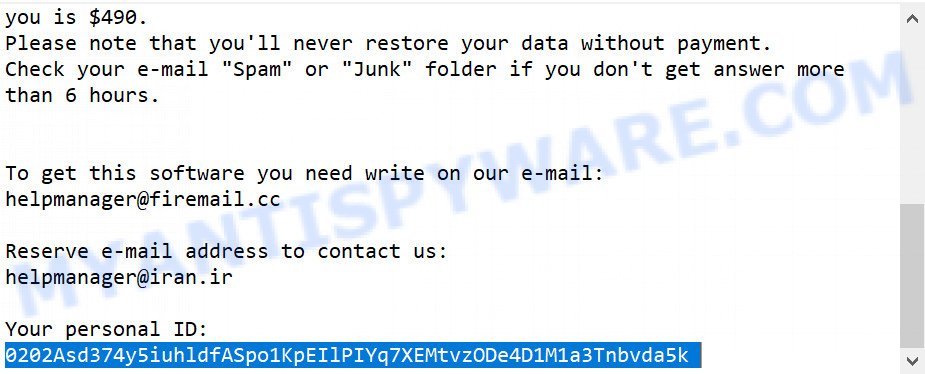
Personal ID is highlighted here
Find out the type of key using ‘_readme.txt’ file
- Open the ransom demand message (‘_readme.txt’ file).
- Scroll down to the end of the file.
- There you will see a line with the text ‘Your personal ID’.
- Below is a line of characters that starts with ‘0237’ – this is your personal id.
Find out the type of key using ‘PersonalID.txt’ file
- Open disk C.
- Open directory ‘SystemID’.
- Open file named ‘PersonalID.txt’. This file lists ‘Personal ID’s that match the keys that the virus used to encrypt files.
The ‘Personal ID’ is not a key, it is an identifier related to a key that was used to encrypt files. If the ID ends with ‘t1’, then the files are encrypted with an offline key. If the ID does not end with ‘t1’, Pykw virus used an online key. If you could not figure out how to determine which key was used to encrypt files, then we can help. Just write a request here or in the comments below.
Pykw File Decrypt Tool : “No key for New Variant online ID”

If, when you try to decrypt .pykw files, Pykw File Decrypt Tool reports:
No key for New Variant online ID: *
Notice: this ID appears to be an online ID, decryption is impossible
It means that your files are encrypted with an ‘online key’ and their decryption is impossible, since only the Pykw authors have the key necessary for decryption. In this case, you need to use alternative methods listed below to restore the contents of encrypted files.
Pykw File Decrypt Tool : “No key for New Variant offline ID”

If, during decryption of .pykw files, Pykw File Decrypt Tool reports:
No key for New Variant offline ID: *t1
Notice: this ID appears be an offline ID, decryption MAY be possible in the future.
It means the following: your files are encrypted with an ‘offline key’, but the key itself has not yet been obtained by security researchers, in this case, you need to be patient and wait a while, in addition, you can also use alternative ways for recovering encrypted data.
If for some reason you were unable to decrypt the encrypted files, then We recommend to follow the news on our Facebook or YouTube channels. So you ‘ll know right away that it ‘s possible to decrypt .pykw files.
How to restore .pykw files
If the Pykw File Decrypt tool cannot decrypt the encrypted files or your data is encrypted with an online key, then there is no need to despair. Fortunately, there are several alternative methods that can allow everyone to recover the contents of encrypted files. Each of these methods does not involve the use of special knowledge and paid programs and can be performed by everyone. We have prepared an instruction with illustrations, which describes in detail the process of data recovery. Before you begin data recovery, if you have not completed step 1, then go back. You must be 100% sure that the Pykw ransomware virus is completely removed. We recommend using free malware removal tools.
Run ShadowExplorer to recover .pykw files
The first and very simple way to restore encrypted files to the state in which they were before encryption is to restore files from their Shadow Copies. The Shadow Volume Copies are copies of files and folders that Windows automatically saved as part of system protection. This feature is fantastic at rescuing personal files that were locked by the Pykw ransomware. The guide below will give you all the details.
Click the following link to download ShadowExplorer. Save it on your Desktop.
439455 downloads
Author: ShadowExplorer.com
Category: Security tools
Update: September 15, 2019
When the download is finished, open a directory in which you saved it. Right click to ShadowExplorer-0.9-portable and select Extract all. Follow the prompts. Next please open the ShadowExplorerPortable folder like below.

Start the ShadowExplorer tool and then select the disk (1) and the date (2) that you wish to recover the shadow copy of file(s) encrypted by the Pykw crypto virus similar to the one below.

Now navigate to the file or folder that you want to restore. When ready right-click on it and click ‘Export’ button like below.

This video step-by-step guide will demonstrate How to recover encrypted files using Shadow Explorer.
Run PhotoRec to recover .pykw files
Another way to recover encrypted files is to use data recovery programs. There are many such programs, but most of them are paid. We recommend using a program called PhotoRec. It has all the necessary functions and is completely free.
Download PhotoRec on your system from the following link.
Once the downloading process is complete, open a directory in which you saved it. Right click to testdisk-7.0.win and choose Extract all. Follow the prompts. Next please open the testdisk-7.0 folder as displayed on the image below.

Double click on qphotorec_win to run PhotoRec for Microsoft Windows. It will display a screen as shown in the following example.

Select a drive to recover as on the image below.

You will see a list of available partitions. Choose a partition that holds encrypted personal files as shown in the following example.

Press File Formats button and specify file types to restore. You can to enable or disable the restore of certain file types. When this is complete, click OK button.

Next, press Browse button to choose where recovered documents, photos and music should be written, then press Search. We strongly recommend that you use an external device to save the restored files!

Count of recovered files is updated in real time. All restored photos, documents and music are written in a folder that you have selected on the previous step. You can to access the files even if the restore process is not finished.
When the recovery is done, press on Quit button. Next, open the directory where recovered personal files are stored. You will see a contents as displayed in the figure below.

All recovered documents, photos and music are written in recup_dir.1, recup_dir.2 … sub-directories. If you’re looking for a specific file, then you can to sort your recovered files by extension and/or date/time.
This video step-by-step guide will demonstrate How to recover encrypted files using PhotoRec.
How to protect your PC from Pykw ransomware
Most antivirus applications already have built-in protection system against the crypto malware. Therefore, if your PC does not have an antivirus program, make sure you install it. As an extra protection, use the HitmanPro.Alert. HitmanPro.Alert is a small security tool. It can check the system integrity and alerts you when critical system functions are affected by malware. HitmanPro.Alert can detect, remove, and reverse ransomware effects.
Download HitmanPro Alert by clicking on the following link.
When the download is done, open the file location. You will see an icon like below.

Double click the HitmanPro Alert desktop icon. Once the tool is started, you will be shown a window where you can choose a level of protection, as displayed in the figure below.

Now click the Install button to activate the protection.
To sum up
This article was created to help all victims of the Pykw ransomware virus. We tried to give answers to the following questions: how to remove ransomware; how to decrypt .pykw files; how to recover files, if the Pykw File Decrypt Tool does not help; what is an online key and what is an offline key. We hope that the information presented in this article has helped you.
If you have questions, then write to us, leaving a comment below. If you need more help with Pykw ransomware related issues, go to here.




















